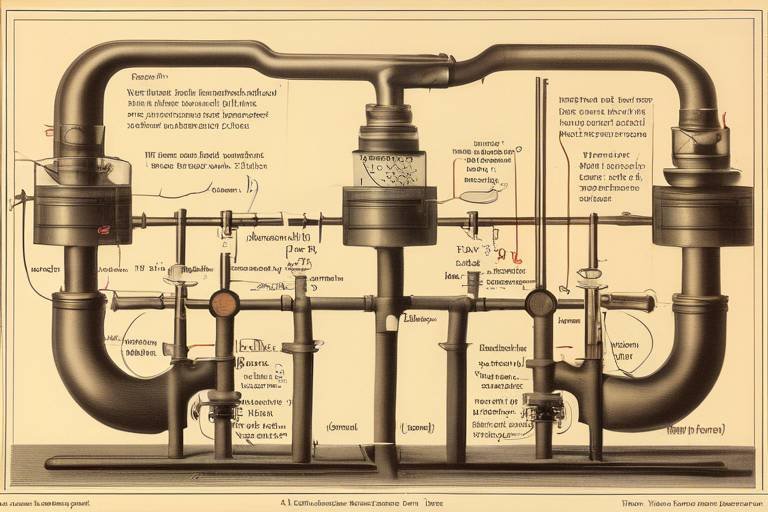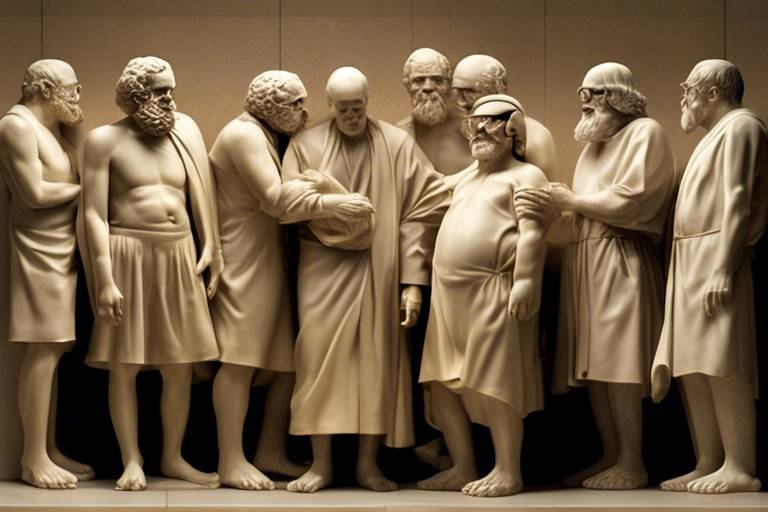Philosophy of Heat Transfer and Thermodynamics
The is not just a set of rules governing energy; it represents a profound understanding of how the universe operates. At its core, this philosophy invites us to ponder the very essence of energy, its transformations, and the intricate dance of particles that dictate the behavior of matter. Imagine heat as a storyteller, weaving tales of energy movement through the fabric of existence. Whether it's the warmth of the sun on your skin or the chill of an ice cube melting in your drink, heat transfer is a constant companion in our lives, influencing everything from the weather to technological innovations.
In exploring this philosophy, we uncover the fundamental principles that govern heat transfer: conduction, convection, and radiation. Each mechanism serves as a unique pathway for energy to flow, much like rivers carving through landscapes. Conduction, for instance, is the direct transfer of heat through materials, akin to a handshake between two friends where warmth is shared. Convection, on the other hand, involves the movement of fluids, creating currents that transport heat—think of it as a dance party where energy is passed from one dancer to another. Lastly, radiation allows heat to travel through the vacuum of space, much like sunlight reaching Earth, reminding us that energy can traverse vast distances without a medium.
As we delve deeper into the philosophy of thermodynamics, we encounter the laws that govern energy transfer. These laws are not merely theoretical constructs; they are the backbone of scientific inquiry and engineering practices. They challenge us to think critically about energy efficiency and sustainability. The first law, which speaks to the conservation of energy, prompts us to consider how we utilize resources in our daily lives. Are we wasting energy, or are we finding innovative ways to harness it? This reflection is not just for scientists; it's a call to action for everyone, urging us to be stewards of our planet.
Moreover, the implications of thermodynamics stretch into the realm of economics and environmental policies. By understanding the principles of energy conservation and transformation, we can develop strategies that minimize waste and optimize resource use. This philosophy encourages a holistic view of our world, where every action has a reaction, and every energy choice impacts the larger system.
In summary, the philosophy of heat transfer and thermodynamics is a rich tapestry of ideas that challenges us to think beyond the surface. It invites us to explore the interconnectedness of energy, matter, and the universe at large. As we navigate this complex landscape, we are reminded of our role in the grand narrative of energy—where every decision counts and every innovation can lead to a more sustainable future.
- What is heat transfer? Heat transfer refers to the movement of thermal energy from one object or system to another, primarily through conduction, convection, and radiation.
- Why are the laws of thermodynamics important? The laws of thermodynamics provide fundamental principles that govern energy transfer and transformation, influencing various scientific and engineering applications.
- How does the first law of thermodynamics apply to everyday life? The first law emphasizes energy conservation, urging us to find efficient ways to use resources in our homes and industries.
- What is the significance of entropy in thermodynamics? Entropy measures the disorder of a system, illustrating how energy disperses and systems evolve towards equilibrium, which is crucial for understanding irreversible processes.

Understanding Heat Transfer
Heat transfer is a fundamental concept in thermodynamics that plays a critical role in our daily lives and the functioning of various systems. It is the process through which thermal energy moves from one body or system to another, driven by temperature differences. Imagine a hot cup of coffee placed on a cold table; the heat from the coffee will transfer to the table until both reach a uniform temperature. This simple yet profound example illustrates the essence of heat transfer and its significance in both nature and technology.
There are three primary mechanisms of heat transfer: conduction, convection, and radiation. Each of these methods has unique characteristics and applications, making them essential to understand for anyone interested in the principles of thermodynamics.
Conduction is the transfer of heat through a solid material, occurring when particles collide and transfer energy. This process is most effective in solids, where molecules are closely packed. For instance, when you touch a metal spoon that has been sitting in a hot pot, the heat from the pot is conducted through the spoon to your hand. The efficiency of conduction depends on the material's thermal conductivity, which varies widely among different substances. Metals, for example, are excellent conductors, while materials like wood or plastic are poor conductors, known as insulators.
Convection, on the other hand, involves the movement of fluid (liquid or gas) and the transfer of heat through the bulk movement of the fluid. When you boil water, the hot water at the bottom rises to the surface while cooler water descends, creating a circulation pattern. This process is crucial in many natural phenomena, such as ocean currents and atmospheric circulation, and in engineered systems like heating and cooling systems. The efficiency of convection is influenced by factors such as fluid velocity, temperature differences, and the nature of the fluid itself.
Lastly, radiation is the transfer of heat through electromagnetic waves, which can occur even in a vacuum. The sun warming your skin on a bright day is a perfect example of heat transfer via radiation. Unlike conduction and convection, radiation does not require a medium, making it unique and essential for understanding energy transfer in space and in various technologies, such as solar panels.
| Mechanism | Medium | Example |
|---|---|---|
| Conduction | Solid | Touching a hot metal pan |
| Convection | Fluid (liquid or gas) | Boiling water |
| Radiation | Vacuum or medium | Sunlight warming the Earth |
Understanding these mechanisms not only deepens our appreciation of the natural world but also enhances our ability to design and optimize systems in engineering and technology. From the efficiency of home heating systems to the design of spacecraft that can withstand extreme temperatures, the principles of heat transfer are everywhere, influencing both our daily lives and future innovations.

The Laws of Thermodynamics
The laws of thermodynamics are not just dry, scientific principles; they are the very foundation of our understanding of energy and its transformations in the universe. These laws govern everything from the engines that power our cars to the refrigerators that keep our food fresh. Without these laws, we would be lost in a world of chaos, unable to predict how energy flows and transforms. Let’s dive into these fundamental principles that shape the physical sciences and our daily lives.
At the heart of thermodynamics, we find three primary laws that outline the behavior of energy. Each law builds upon the last, creating a framework that helps us understand how energy interacts with matter. The first law, often referred to as the Law of Conservation of Energy, tells us that energy cannot be created or destroyed but can only change forms. This means that in any closed system, the total energy remains constant, even as it transforms from one type to another, such as from kinetic energy to thermal energy.
The second law introduces the concept of entropy, a measure of disorder or randomness in a system. It explains that energy tends to disperse or spread out over time, leading to an increase in entropy. This is why a hot cup of coffee cools down in a cold room; the thermal energy from the coffee moves to the surrounding air, increasing the overall entropy of the system. The second law highlights the inevitable direction of natural processes, where systems evolve towards equilibrium, and it emphasizes that energy transformations are not 100% efficient—some energy is always lost as waste heat.
Finally, the third law of thermodynamics states that as the temperature of a system approaches absolute zero, the entropy of a perfect crystal approaches zero as well. This law helps us understand the behavior of materials at extremely low temperatures and has profound implications in fields such as cryogenics and quantum mechanics.
To summarize, the laws of thermodynamics can be encapsulated as follows:
| Law | Description |
|---|---|
| First Law | Energy cannot be created or destroyed, only transformed. |
| Second Law | Energy transformations are not 100% efficient; entropy tends to increase. |
| Third Law | As temperature approaches absolute zero, the entropy of a perfect crystal approaches zero. |
Understanding these laws is crucial for various scientific and engineering disciplines. They provide insights into energy management, efficiency improvements, and even the development of sustainable technologies. The implications of thermodynamics extend beyond the lab; they influence economic policies and environmental strategies aimed at reducing waste and optimizing resource use. In essence, the laws of thermodynamics are not just theoretical constructs; they are the guiding principles that help us navigate the intricate dance of energy in our universe.
- What is the significance of the laws of thermodynamics? The laws of thermodynamics provide a framework for understanding how energy is transferred and transformed in physical systems, impacting everything from engineering to environmental science.
- How do the laws of thermodynamics apply to everyday life? These laws govern the functioning of everyday appliances, vehicles, and even biological processes, helping us understand energy efficiency and conservation.
- Can energy be created or destroyed? According to the first law of thermodynamics, energy cannot be created or destroyed; it can only change forms.

First Law: Conservation of Energy
The First Law of Thermodynamics is a fundamental principle that states energy cannot be created or destroyed; it can only be transformed from one form to another. Imagine energy as a currency in a vast economy—just like money can change hands or be converted into different currencies, energy flows through various systems, changing its form but never disappearing. This law is crucial not just in theoretical physics but also in practical applications across a multitude of fields.
In essence, when we talk about energy transformations, we are referring to processes like converting chemical energy in fuel into mechanical energy in engines or transforming electrical energy into heat in a toaster. Every time energy changes forms, it adheres to this law, ensuring that the total amount of energy remains constant within a closed system. This concept is vital for engineers, scientists, and anyone involved in energy management.
To better understand the implications of the First Law, let's look at some practical applications:
- Mechanical Engineering: In mechanical systems, understanding energy conversion helps in designing efficient machines that minimize energy loss.
- Environmental Science: The principles of energy conservation guide sustainable practices, ensuring that resources are used efficiently to protect our environment.
- Thermal Systems: In heating and cooling applications, the First Law helps engineers optimize systems to maintain desired temperatures with minimal energy consumption.
Furthermore, the implications of energy conservation extend beyond the realms of science and engineering. They influence economic policies and environmental strategies aimed at reducing waste and optimizing resource use. For instance, governments worldwide are adopting regulations that promote energy efficiency in industries and households, which is a direct application of the First Law. By fostering a culture of energy conservation, societies can work towards a sustainable future while also enhancing economic growth.
In summary, the First Law of Thermodynamics is not just a theoretical concept; it is a guiding principle that shapes our understanding of energy in the world around us. Its applications are vast, impacting everything from the design of engines to the policies that govern our energy consumption. By embracing this law, we can innovate and develop solutions that lead to a more efficient and sustainable world.

Applications of the First Law
The first law of thermodynamics, which emphasizes the conservation of energy, is not just a theoretical concept confined to textbooks; it has profound implications across various fields, transforming how we approach energy management and utilization. Imagine a world where energy is treated as a precious resource rather than a mere commodity—this principle is at the heart of sustainable practices in engineering, environmental science, and even economics. By understanding and applying this law, we can innovate solutions that enhance energy efficiency and reduce waste.
In mechanical engineering, for instance, the first law plays a crucial role in the design and optimization of engines. Engineers utilize this principle to maximize the energy output from fuel, ensuring that as much thermal energy as possible is converted into useful work. This not only improves performance but also contributes to lower emissions, which is vital in combating climate change. The automotive industry, in particular, has seen significant advancements through the application of this law, leading to the development of hybrid and electric vehicles that are more energy-efficient than their traditional counterparts.
Moreover, in the realm of chemistry, the first law is fundamental in understanding chemical reactions and processes. It allows chemists to calculate the energy changes that occur during reactions, helping them to develop new materials and methods that are more efficient and less wasteful. For example, in the synthesis of pharmaceuticals, energy conservation principles guide the optimization of reaction conditions, leading to higher yields and reduced resource consumption.
In environmental science, the implications of the first law extend to policies aimed at promoting sustainability. By emphasizing energy conservation, policymakers can create regulations and incentives that encourage industries to adopt more efficient technologies. This not only helps in reducing the carbon footprint but also fosters economic growth by driving innovation and creating jobs in green technologies.
To illustrate the practical applications of the first law, consider the following table that summarizes its impact across various sectors:
| Sector | Application | Impact |
|---|---|---|
| Mechanical Engineering | Engine design and optimization | Increased efficiency and reduced emissions |
| Chemistry | Reaction energy calculations | Higher yields and resource conservation |
| Environmental Science | Energy conservation policies | Promotes sustainability and innovation |
In summary, the first law of thermodynamics is a guiding principle that transcends disciplines, influencing how we generate, utilize, and conserve energy. Its applications not only enhance efficiency in various fields but also pave the way for sustainable practices that can benefit society as a whole. As we continue to face challenges related to energy consumption and environmental impacts, embracing the first law's implications will be essential for fostering a more sustainable future.
- What is the first law of thermodynamics?
The first law states that energy cannot be created or destroyed, only transformed from one form to another. - How does the first law apply to everyday life?
It influences energy usage in appliances, vehicles, and industrial processes, promoting efficiency and sustainability. - Why is energy conservation important?
Energy conservation helps reduce waste, lower costs, and minimize environmental impacts, contributing to a sustainable future.

Implications of Energy Conservation
Energy conservation is not just a scientific principle; it's a philosophy that echoes through our daily lives and the broader framework of society. When we talk about energy conservation, we are essentially discussing a fundamental shift in how we perceive and utilize energy resources. The implications of this shift are vast and multifaceted, affecting everything from our economic systems to our environmental strategies. Imagine a world where energy is treated as a precious commodity rather than an endless supply. This mindset can lead to significant changes in behavior, policy, and technology.
One of the most profound implications of energy conservation is its potential to drive sustainability. By reducing energy consumption, we can lessen our reliance on fossil fuels, thereby decreasing greenhouse gas emissions. This shift is crucial in combating climate change and preserving our planet for future generations. Moreover, energy conservation can lead to economic benefits. Businesses that adopt energy-efficient practices often experience lower operating costs, which can translate into higher profits. This is not just a win for the environment; it’s a win for the economy as well.
In addition, the implications extend into the realm of social consciousness. As individuals become more aware of their energy consumption, they may adopt more sustainable lifestyles. This could involve simple changes, such as using energy-efficient appliances or opting for public transportation. Additionally, communities can come together to promote energy-saving initiatives, fostering a sense of collective responsibility. The question arises: can we shift from being energy consumers to becoming energy stewards? The answer lies in education and awareness.
Furthermore, energy conservation influences government policies. Policymakers are increasingly recognizing the need for regulations that promote energy efficiency. This includes incentives for renewable energy projects, tax breaks for energy-efficient home improvements, and stricter regulations on emissions. The relationship between energy conservation and policy is symbiotic; as society demands more sustainable practices, governments are pushed to respond accordingly.
To illustrate the profound impact of energy conservation, consider the following table that summarizes key areas influenced by energy conservation:
| Area | Impact |
|---|---|
| Environment | Reduction in greenhouse gas emissions and pollution |
| Economy | Lower operational costs and increased profitability for businesses |
| Social Awareness | Enhanced community involvement in sustainability initiatives |
| Policy | Development of regulations promoting energy efficiency |
In conclusion, the implications of energy conservation reach far beyond the realm of science. They touch on economic, environmental, and social dimensions, creating a holistic approach to energy use that is critical for our future. As we embrace energy conservation, we not only enhance our quality of life but also pave the way for a sustainable and prosperous world. The journey towards energy efficiency is a collective effort, and every small step counts. So, how will you contribute to this vital cause?
- What is energy conservation? Energy conservation refers to the practice of using less energy by implementing more efficient processes and technologies.
- Why is energy conservation important? It is crucial for reducing greenhouse gas emissions, saving money, and promoting sustainability.
- How can individuals contribute to energy conservation? Individuals can reduce energy consumption by using energy-efficient appliances, reducing waste, and being mindful of their energy use.
- What are some common energy conservation practices in businesses? Common practices include upgrading to energy-efficient lighting, optimizing heating and cooling systems, and implementing energy management systems.

Second Law: Entropy and Disorder
The Second Law of Thermodynamics is a fascinating and somewhat perplexing principle that introduces us to the concept of entropy. At its core, this law states that in any energy transfer or transformation, the total entropy of a closed system can never decrease over time. In simpler terms, it means that energy tends to spread out or disperse, leading to a state of greater disorder. Imagine your room after a wild party: it starts off neat and tidy, but as the night progresses, it becomes increasingly chaotic. This is a perfect metaphor for entropy in action!
Entropy is often described as a measure of disorder or randomness in a system. The higher the entropy, the more disordered the system is. This principle is essential for understanding why certain processes are irreversible. For example, when you mix cream into coffee, you can’t unmix them; the system has moved towards a state of higher entropy. The cream disperses throughout the coffee, creating a uniform mixture that is more disordered than the separate components. This is a natural progression, and it reflects the inevitable tendency of energy to spread out.
One of the most intriguing aspects of the Second Law is its implications for the universe as a whole. The universe is constantly moving towards a state of maximum entropy, often referred to as the "heat death" of the universe. This scenario suggests that, eventually, all energy will be evenly distributed, and no useful work can be extracted from it. It’s a thought-provoking idea that challenges our understanding of time and existence, pushing us to consider the ultimate fate of everything around us.
To put it in perspective, consider the following examples that illustrate the concept of entropy:
- Melting Ice: When ice melts, it transitions from an ordered solid state to a more disordered liquid state, increasing the system's entropy.
- Gas Expansion: When a gas expands into a vacuum, it fills the available space, moving from a more ordered state to a more disordered one, thus increasing entropy.
- Mixing Gases: If you have two different gases in separate containers and you allow them to mix, the resulting mixture has higher entropy than the initial state.
Understanding entropy is crucial not only in physics but also in various fields like chemistry, biology, and even information technology. For instance, in chemical reactions, the tendency for reactions to proceed in a direction that increases entropy can help predict the feasibility and spontaneity of those reactions. Similarly, in information theory, entropy quantifies the uncertainty in a set of possible outcomes, which is essential for data compression and transmission.
In summary, the Second Law of Thermodynamics and the concept of entropy challenge us to rethink our understanding of energy and disorder in the universe. It reminds us that while we may strive for order and efficiency in our lives, nature has a tendency to lean towards chaos and randomness. Embracing this reality can lead to a deeper appreciation for the complex systems that govern our world.
Q1: What is entropy in simple terms?
Entropy is a measure of disorder or randomness in a system. Higher entropy means more disorder.
Q2: Why is the Second Law of Thermodynamics important?
It explains why energy transformations are not 100% efficient and helps us understand natural processes and the direction of energy flow.
Q3: Can entropy decrease in a closed system?
No, according to the Second Law, the total entropy of a closed system can never decrease; it can only increase or remain constant.
Q4: How does entropy relate to everyday life?
Entropy can be observed in daily life, such as when ice melts, food spoils, or when you clean a room that inevitably gets messy again.

Thermodynamic Cycles
Thermodynamic cycles are fascinating constructs that allow us to understand the conversion of heat into work. Imagine a well-oiled machine, where every component is perfectly synchronized to transform energy efficiently. This is essentially what thermodynamic cycles do—they illustrate how energy flows and transforms within a system, providing insights that are crucial for engineers and scientists alike. By studying these cycles, we can optimize processes in everything from power generation to refrigeration, making them not just theoretical concepts but practical tools that drive innovation.
There are several key thermodynamic cycles that have been developed over the years, each with its specific applications and efficiencies. Among the most notable are the Carnot Cycle and the Rankine Cycle. The Carnot cycle serves as a benchmark for the maximum possible efficiency of a heat engine, while the Rankine cycle is widely used in practical power generation systems. Understanding these cycles requires a look at their components and the principles that govern them.
At its core, a thermodynamic cycle consists of a series of processes that return a system to its initial state. These processes can be isothermal (constant temperature), adiabatic (no heat exchange), isobaric (constant pressure), or isochoric (constant volume). The interplay of these processes dictates the efficiency and performance of the cycle. For example, in the Carnot cycle, two isothermal processes and two adiabatic processes work together to maximize work output while minimizing energy loss.
To illustrate the differences in efficiency and application, let’s take a closer look at the two prominent cycles:
| Cycle | Key Features | Applications |
|---|---|---|
| Carnot Cycle |
|
Benchmark for heat engines |
| Rankine Cycle |
|
Power generation in steam power plants |
Understanding these cycles not only helps in optimizing existing technologies but also paves the way for new innovations. For instance, advancements in materials and designs for heat exchangers can lead to more efficient Rankine cycles, which in turn can produce more electricity from the same amount of fuel. This ripple effect highlights the importance of thermodynamic cycles in our quest for sustainable energy solutions.
Moreover, the implications of these cycles extend beyond engineering. They touch on economic and environmental issues as well. For instance, improving the efficiency of thermodynamic cycles can lead to reduced fuel consumption, which translates to lower greenhouse gas emissions. This is a critical consideration in today’s world, where energy conservation is not just a goal but a necessity.
In conclusion, thermodynamic cycles are essential for understanding how we can convert heat into work efficiently. They are the backbone of many technologies that power our world, and by delving deeper into their mechanics, we can unlock new possibilities for energy use and sustainability.
- What is a thermodynamic cycle? A thermodynamic cycle is a series of processes that return a system to its initial state, allowing for the conversion of heat into work.
- What are the main types of thermodynamic cycles? The main types include the Carnot cycle, Rankine cycle, Brayton cycle, and Otto cycle, each with distinct features and applications.
- Why is the Carnot cycle important? The Carnot cycle serves as a benchmark for the maximum efficiency of heat engines, highlighting the limits of thermodynamic processes.

Carnot Cycle: The Ideal Engine
The Carnot cycle is often hailed as the gold standard of thermodynamic processes, representing an idealized engine that serves as a benchmark for the efficiency of real-world engines. Imagine a perfectly efficient engine that converts heat energy into work without any losses—this is the essence of the Carnot cycle. Developed by the French physicist Sadi Carnot in the early 19th century, this cycle demonstrates the fundamental principles of thermodynamics in a way that is both enlightening and practical.
At its core, the Carnot cycle consists of four reversible processes: two isothermal processes and two adiabatic processes. To visualize this, think of a perfectly insulated balloon that can expand and contract without losing any heat. The cycle begins with the gas inside the balloon absorbing heat from a hot reservoir at a constant temperature (isothermal expansion). As the gas expands, it does work on the surroundings, pushing against a piston. This is where the magic happens—energy is transformed, but none is wasted!
Next, the gas undergoes an adiabatic expansion, where it expands without exchanging heat with its environment. This phase is crucial because it allows the gas to cool down, demonstrating how energy can be transformed while maintaining the system's internal energy. After this, the gas is compressed isothermally, releasing heat to a cold reservoir, and finally, it undergoes adiabatic compression, returning to its initial state. This entire process showcases the efficiency of the Carnot cycle, which can be expressed mathematically as:
| Efficiency (η) | Formula |
|---|---|
| η | 1 - (Tcold / Thot) |
Where Tcold and Thot are the absolute temperatures (in Kelvin) of the cold and hot reservoirs, respectively. This formula illustrates that the efficiency of the Carnot engine depends solely on the temperatures of the reservoirs, not on the working substance. It’s a remarkable insight that reveals the limitations of real engines, as no practical engine can achieve 100% efficiency due to unavoidable heat losses.
The Carnot cycle is not just an academic exercise; it has profound implications in the real world. Engineers and scientists use the principles of the Carnot cycle to design more efficient engines and refrigeration systems. For instance, modern power plants strive to operate as close to the Carnot efficiency as possible, thereby maximizing energy output while minimizing fuel consumption. This pursuit of efficiency is not merely about performance; it also has significant environmental impacts. By reducing fuel usage, we can lessen greenhouse gas emissions and decrease our reliance on fossil fuels, paving the way for a more sustainable future.
In summary, the Carnot cycle serves as an ideal model that illustrates the maximum efficiency achievable by a heat engine. By understanding its principles, we can better appreciate the challenges and opportunities in energy conversion technologies. Whether you’re an aspiring engineer or just someone curious about the mechanics of heat and energy, the Carnot cycle opens a fascinating window into the world of thermodynamics.
- What is the Carnot cycle? The Carnot cycle is an idealized thermodynamic cycle that demonstrates the maximum possible efficiency of a heat engine.
- Why is the Carnot cycle important? It sets a benchmark for the efficiency of real engines and helps engineers design more efficient systems.
- Can real engines achieve Carnot efficiency? No, real engines cannot achieve 100% efficiency due to various energy losses.
- What are the four processes in the Carnot cycle? The four processes are two isothermal processes and two adiabatic processes.

Rankine Cycle: Practical Applications
The Rankine cycle serves as a cornerstone in the realm of power generation, showcasing how heat can be efficiently transformed into work. This thermodynamic cycle is primarily utilized in steam power plants, where water is heated to produce steam that drives turbines, ultimately generating electricity. The efficiency and practicality of the Rankine cycle make it a vital player in modern energy systems, allowing us to harness thermal energy effectively.
In essence, the Rankine cycle consists of four key processes: isothermal expansion, adiabatic expansion, isothermal compression, and adiabatic compression. Each of these processes plays a critical role in ensuring the cycle operates smoothly and efficiently. To break it down further:
- Isothermal Expansion: Here, the working fluid (usually water) absorbs heat from a high-temperature source, causing it to expand and do work on the turbine.
- Adiabatic Expansion: In this stage, the steam expands without heat exchange, continuing to do work as it cools down.
- Isothermal Compression: The working fluid is then condensed back into liquid form by rejecting heat to a low-temperature sink, typically through a cooling tower.
- Adiabatic Compression: Finally, the liquid is compressed back to high pressure, preparing it to absorb heat again.
This cycle is not just theoretical; it has practical implications that extend into various industries. For instance, the Rankine cycle is widely implemented in coal-fired power plants, where coal is burned to produce steam. Additionally, it finds applications in nuclear power plants, where nuclear reactions generate the necessary heat. Even in geothermal power plants, the Rankine cycle plays a crucial role by utilizing heat from the Earth’s core to produce energy.
To illustrate the efficiency of the Rankine cycle, consider a typical steam power plant. The thermal efficiency of these plants can be significantly influenced by several factors, including:
| Factor | Impact on Efficiency |
|---|---|
| Temperature of Heat Source | Higher temperatures increase efficiency by maximizing the energy extracted from the steam. |
| Pressure of Working Fluid | Higher pressures lead to greater energy conversion and improved cycle efficiency. |
| Quality of Steam | Superheated steam can enhance efficiency by preventing condensation in the turbine. |
Moreover, the Rankine cycle is not limited to just electricity generation. It can also be adapted for combined heat and power (CHP) systems, where both electricity and useful heat are produced simultaneously, maximizing overall energy utilization. This adaptability is crucial in our quest for more sustainable energy solutions, as it allows us to reduce waste and improve efficiency.
In conclusion, the Rankine cycle is more than just a theoretical concept; it is a practical framework that underpins a significant portion of our energy production today. By understanding its applications and the principles that govern it, we can continue to innovate and push the boundaries of energy efficiency, paving the way for a more sustainable future.
- What is the Rankine cycle? The Rankine cycle is a thermodynamic cycle that converts heat into work, primarily used in steam power generation.
- How does the Rankine cycle work? It consists of four processes: isothermal expansion, adiabatic expansion, isothermal compression, and adiabatic compression, which together convert thermal energy into mechanical work.
- What are the main applications of the Rankine cycle? It is widely used in coal-fired, nuclear, and geothermal power plants, as well as in combined heat and power systems.
- How can the efficiency of the Rankine cycle be improved? Efficiency can be enhanced by increasing the temperature and pressure of the heat source and using superheated steam.
Frequently Asked Questions
- What is heat transfer?
Heat transfer is the process by which thermal energy moves from one system to another. It occurs through three primary mechanisms: conduction, convection, and radiation. Understanding these mechanisms is vital for many scientific and engineering applications, as they govern how heat energy is exchanged in various environments.
- What are the laws of thermodynamics?
The laws of thermodynamics are fundamental principles that describe how energy is transferred and transformed. There are four key laws: the first law, which focuses on the conservation of energy; the second law, which introduces the concept of entropy; the third law, which deals with absolute zero; and the zeroth law, which establishes thermal equilibrium. Together, they form the backbone of physical sciences.
- How does the first law of thermodynamics apply in real life?
The first law of thermodynamics states that energy cannot be created or destroyed, only transformed. This principle is crucial in various fields such as mechanical engineering, chemistry, and environmental science. For instance, it helps engineers design more efficient engines and systems that minimize energy waste, promoting sustainability and innovation in technology.
- What is entropy and why is it important?
Entropy is a measure of disorder or randomness in a system. According to the second law of thermodynamics, entropy tends to increase over time, meaning that energy disperses and systems evolve towards equilibrium. This concept is essential for understanding irreversible processes in nature and helps explain why certain energy transformations are not 100% efficient.
- Can you explain the Carnot cycle?
The Carnot cycle is an idealized thermodynamic process that represents the maximum efficiency achievable by any heat engine. It consists of four stages: two isothermal processes and two adiabatic processes. Understanding the Carnot cycle is crucial for advancements in thermal efficiency, as it sets a benchmark for real-world engines.
- What is the Rankine cycle used for?
The Rankine cycle is widely used in power generation, particularly in steam power plants. It involves converting heat into work through a series of processes, including heating, vaporization, expansion, and condensation. This cycle is significant because it allows for the efficient generation of electricity from thermal energy sources.



















